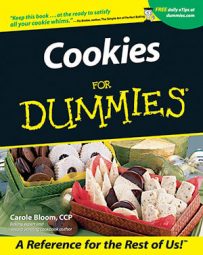Top tips for baking cookies
Baking cookies is fun, right? It is if you take the time to prepare yourself and your kitchen. Go through these steps to help you get set up and make great cookies:
-
Set aside enough time to enjoy the cookie-baking experience.
-
Read through each recipe thoroughly so you know what to do.
-
Check to make sure that you have all the ingredients needed to make the recipes you choose.
-
Prepare the ingredients by measuring them and do other steps that may be needed, such as chopping nuts or grinding spices.
-
Assemble the necessary equipment.
-
Make sure that your workspace is clean and organized.
-
Preheat the oven before baking.
-
Leave space between cookies on the cookie sheet so that they have room to spread as they bake.
-
Don’t forget to set the timer when the cookies are in the oven.
-
Let the cookies cool completely before storing them.
-
Taste to make sure that you’re satisfied with the results of your baking efforts. And then taste again (just to make sure)!
Ingredient substitutions for cookie recipes
If you’re making cookies and find out you’re missing a recipe ingredient (hey, it happens to the best of us) keep this list handy so you know what can be substituted:
| In place of | Use |
|---|---|
| 1 cup light brown sugar | 1 cup sugar plus 3 tablespoons molasses or 1/2 cup sugar plus 1/2 cup dark brown sugar |
| 1 cup dark brown sugar | 1 cup sugar plus 1/4 cup molasses |
| 1 cup sugar | 1 cup superfine sugar or 2 cups powdered sugar or 1 cup firmly packed light brown sugar |
| 1 cup confectioners’ sugar | 1/2 cup plus 1 tablespoon sugar |
| 1 cup all-purpose flour | 1 cup plus 2 tablespoons cake flour |
| 1 cup cake flour | 1 cup minus 2 tablespoons all-purpose flour |
| 1 teaspoon baking powder | 1/2 teaspoon cream of tartar plus 1/4 teaspoon baking soda |
| 1 ounce unsweetened baking chocolate | 3 tablespoons cocoa powder plus 1 tablespoon butter |
| 1 ounce semisweet chocolate | 1/2 ounce unsweetened chocolate plus 1 tablespoon sugar |
| 1 cup light corn syrup | 1-1/4 cups sugar or firmly packed brown sugar and 1/3 cup water boiled together until the sugar dissolves |
| 1 cup dark corn syrup | 3/4 cup light corn syrup plus 1/4 cup molasses |
| 1 cup milk | 1/2 cup evaporated milk plus 1/2 cup water |
Cutting the fat in cookie recipes
If you’re looking to slim down your cookie recipes without giving up on the flavor, try these tips for reducing the fat in your favorite recipe:
-
Using fruit purées to lower fat — Start with half the amount of puréed fruit to replace the fat called for in a recipe. You may need to add more if the cookies are too dry. Keep mixing to a minimum — too much added air will cause the cookies to rise in the oven, but deflate as they cool. Bake the cookies for the least amount of time stated in the recipe, adding more baking time if necessary.
-
Replacing bad fats with good fats — Replace butter or margarine high in saturated fat with a small amount of oil (like canola) that is high in unsaturated fat in your cookie recipes. A good general rule when substituting oil for butter is to use 1 tablespoon of oil in place of 4 tablespoons of butter. Think of butter as an accent flavor rather than a main ingredient. Use parchment paper or nonstick vegetable oil on your cookie sheets to ensure a reduction of the fat in your cookies. Also, reduce the sugar in the recipe by two or three tablespoons, and the finished cookie will be close to the original full-fat one.
-
Using egg whites to cut fat in place of whole eggs — Two egg whites are equal to one whole egg. You can also determine the number of egg whites by measuring them in a liquid measuring cup. One-half cup is equal to three large egg whites.
-
Reducing fat by cutting down on nuts — Although nuts are delicious, they still have a lot of fat. Cut the amount of nuts in recipes by one-third to one-half and replace some of that with flour. You can also toast the nuts to enhance their flavor.
Tips for icing cookies
If you want to top off your cookies with a sweet, creamy icing and keep them looking as great as they taste just follow these handy tips to ensure that your frosting efforts are a success:
-
Be sure that cookies are completely cool before applying icing or it will melt.
-
Test the consistency of the icing. If it’s too thick, thin with a few drops of water.
-
Use a small offset or flexible-blade spatula or a rubber spatula to apply the icing. Push it from the center of the cookie to the edges.
-
Work quickly so that the icing doesn’t dry out and start to set before you’re finished.
-
Keep your spatula clean between applications of icing by dipping it in a cup of warm water. Dry the spatula before putting it back in the container of icing.
-
Use icing in a parchment paper pastry cone or plastic pastry bag to apply accent colors and designs such as dots, lines, squiggles, and borders. Cleanup is a breeze because these tools are disposable.
Make sure that the icing is completely dry before storing iced cookies. They’re best when stored for no more than 2 weeks at room temperature in a tightly sealed container between layers of wax paper. If they’re stored for a longer time, the icing can start to soften the cookies.

